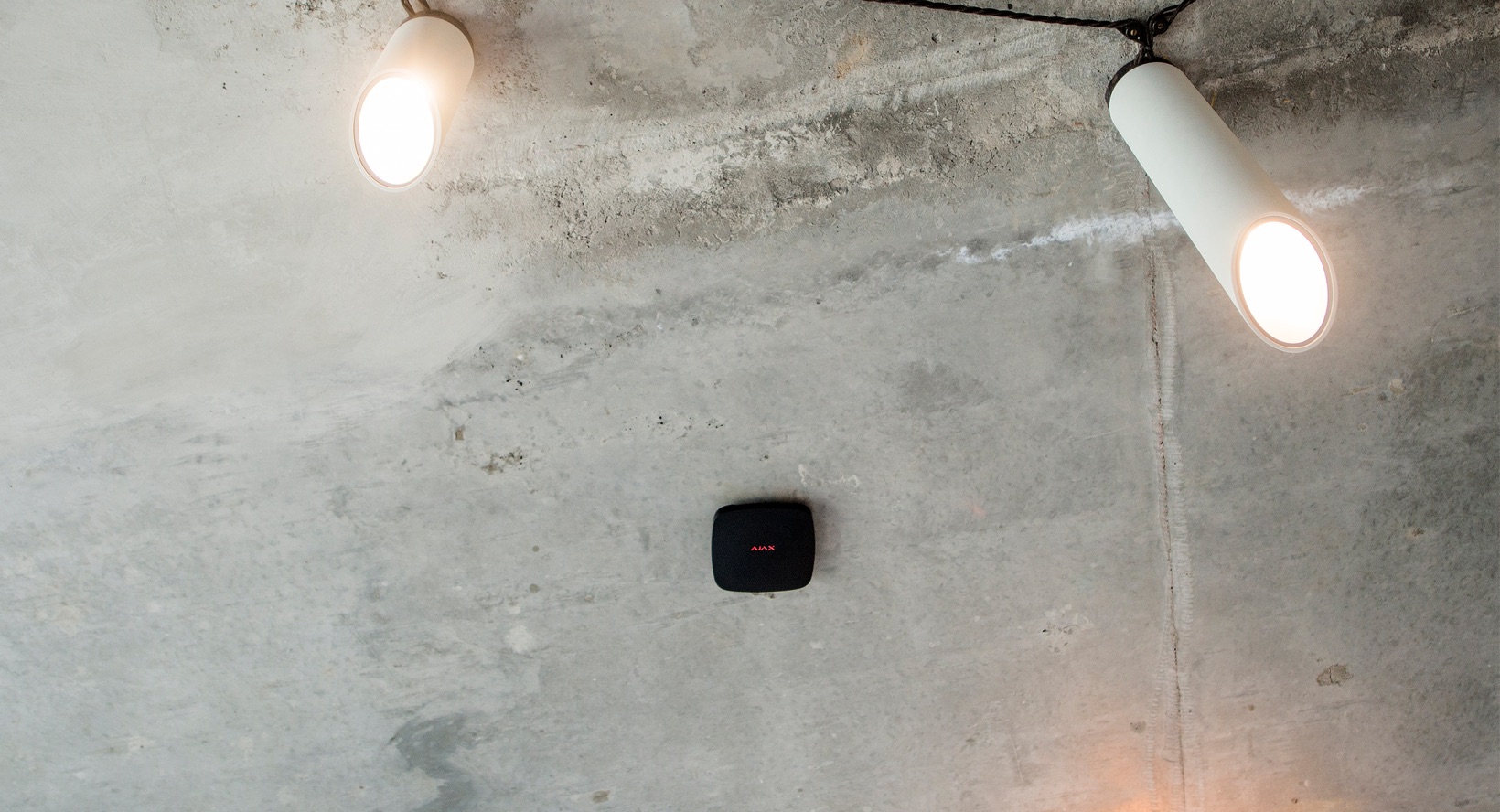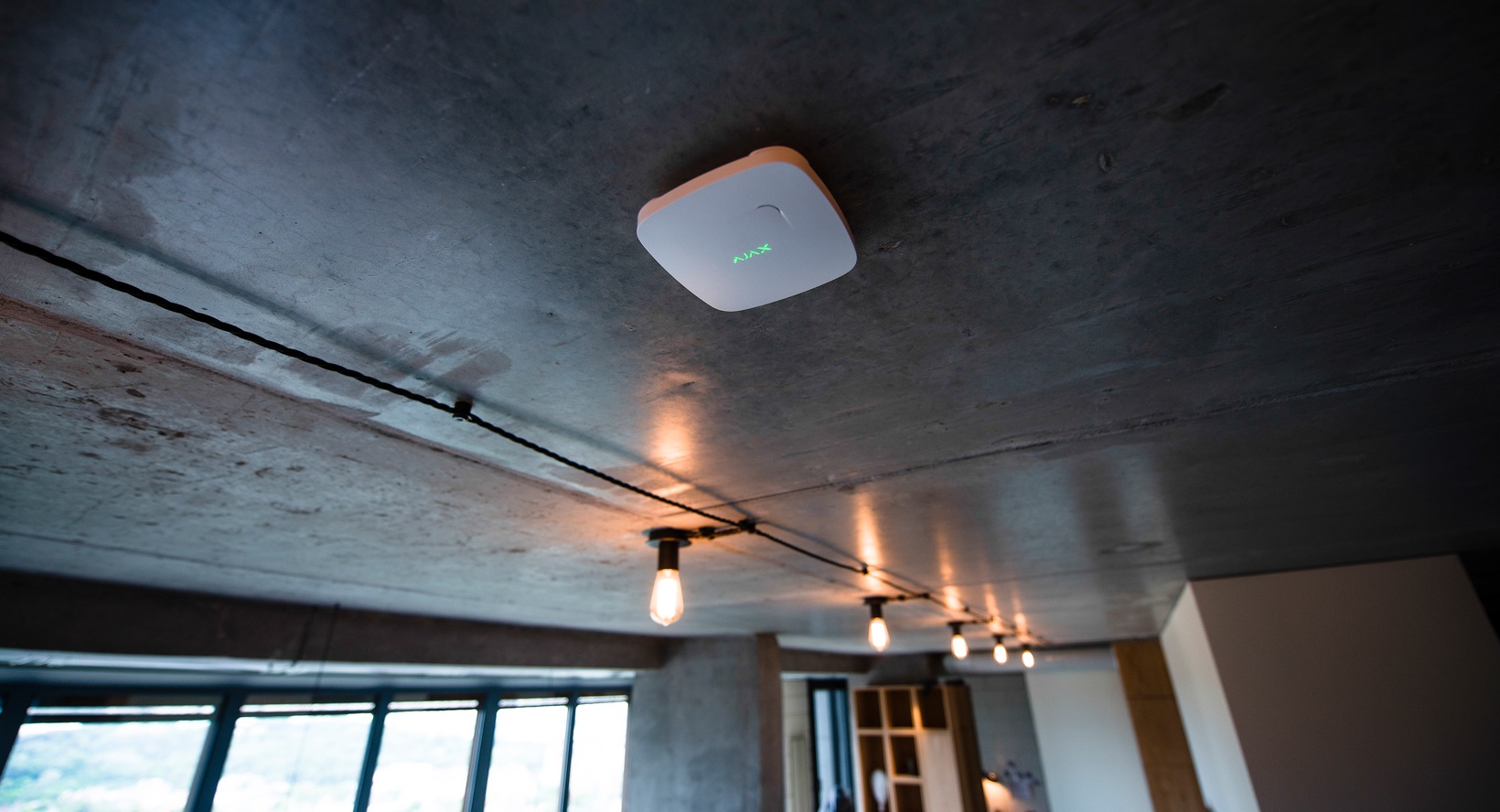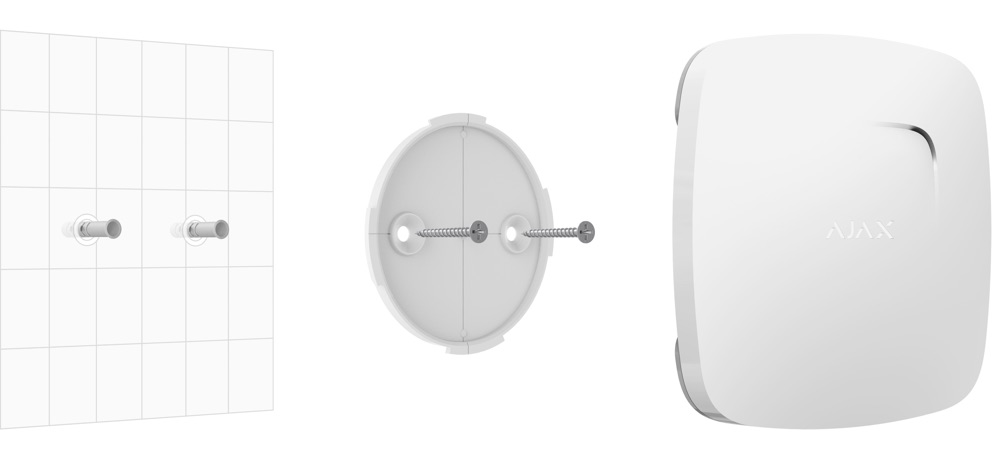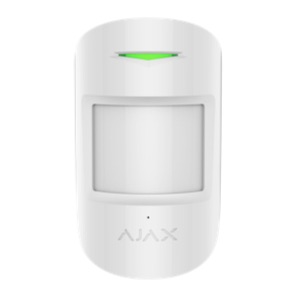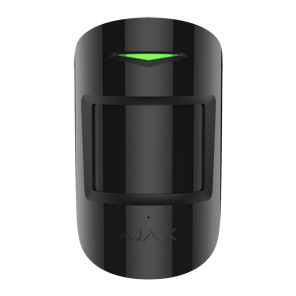FireProtect Jeweller
Wireless fire detector with temperature sensor that monitors security in the room twenty four hours a day and immediately notifies of smoke and sharp jumps in temperature.
-
Certification
Registers smoke and sharp jumps in temperature in the room
Can operate independently from Ajax Hub, notifying of danger by means of a built-in siren
Independently tests the smoke chamber and gives prompt notification of the need to dust
Principle of operation
The device detects smoke by means of a camera with photoelectric sensor. If no smoke is emitted, the additional detector registers temperature increase in the room.
Features
It can operate independently from the hub, emitting a fire alarm by means of a built-in siren. Several detectors indicate an alarm simultaneously.
Installation and set up
Ready to operate straight out the box: the battery is already installed, therefore there is no need to disassemble the detector. With one click, it can be connected to the hub in the mobile application. It can be mounted on the SmartBracket in just a few minutes.
Principle of operation
The device detects smoke by means of a camera with photoelectric sensor. If no smoke is emitted, the additional detector registers temperature increase in the room.
Features
It can operate independently from the hub, emitting a fire alarm by means of a built-in siren. Several detectors indicate an alarm simultaneously.
Installation and set up
Ready to operate straight out the box: the battery is already installed, therefore there is no need to disassemble the detector. With one click, it can be connected to the hub in the mobile application. It can be mounted on the SmartBracket in just a few minutes.
Choose the most suitable Ajax set in 2 minutes
Tell us what you need to protect and we will put together a set of detectors and devices for your premises.
Start
Recommended products
What is a wireless fire sensor
Wireless smoke detector is an element of the fire safety system that detects the signs of a fire and sends danger signals to a burglar alarm or to other security system users. The installation of a fire alarm sensor makes it possible to prevent the spread of fire in time.Types of fire sensors
Depending on the principle of operation and purpose, the following types of fire sensors are distinguished:- fire detectors;
- thermal detectors;
- smoke detectors.
Fire detectors
For the initial stage of fire detection, there is a sensor that detects fire. The wireless fire detector responds initially until the heat level rises. Such a fire sensor can be installed in open areas and areas with high heat transfer. Fire sensors of this type detect ignition by fire or light radiation from decay.Thermal fire sensors
Sensors that detect a fire by temperature are called thermal fire sensors — they are used in cases where there is no smoke from a fire. Types of thermal sensors of the fire alarm system:- Differential — a reaction to the rate of the temperature rise.
- Thresholds — the definition of the increase in heat exceeding the previously established temperature threshold.
Fire smoke sensor
Devices that respond to smoke are called smoke detectors. With their help, you can stop the fire in the initial stages as the smoke from the beginning of the fire is immediately fixed. The smoke sensor responds to smoke even in small quantities, after which an alarm is triggered. Such a smoke sensor can also serve as protection against carbon monoxide poisoning. There are corresponding smoke sensors for smoke with different chemical compositions:- Optoelectronic reacts to smoke, which varies depending on the products of combustion, which affects the environment's optical reactions.
- Ionization — high sensitivity and energy saving. The change in ion current affected by the smoke is recorded.
Ajax FireProtect wireless fire detection sensor
A wireless fire detector will provide round-the-clock fire safety monitoring in the room. The Ajax FireProtect instantly reports smoke and sudden temperature jumps.How the Ajax FireProtect works
The Ajax FireProtect fire sensor detects fires using an infrared emitter and photodetector in a protected room. These elements are embedded in the smoke chamber. When smoke particles enter the section, the photodetector detects the distortion of the infrared beam. If the amount of smoke increases, the distortion of the beam becomes strong, and the fire sensor sends fire alarms to the smart control panel Ajax Hub, after which the siren sounds. The Ajax FireProtect wireless fire sensor can detect smoke in living spaces, shops, educational centres, offices, etc.Features of the Ajax FireProtect wireless fire sensor
The wireless sensor detects smoke and rising temperatures in a room without the smoke. The device can work autonomously using Ajax ocBridge Plus and Ajax uartBridge receivers and a smart Hub control panel, which is maintained at a distance of up to 2000 meters, providing direct visibility. The detector consumes less energy, adapting power to the distance to the Hub smart control panel, and is also subject to remote testing of communication quality and detection area. Two pre-installed CR2 batteries power the fire sensor for up to 3 years. The operability of the fire extinguisher is checked every 5 minutes. The case of the fire alarm system sensor is protected from opening and dismantling by a tamper — the miniature button on a device board. It is squeezed when opening the case, removing the mount or trying to tear the fire sensor from the surface, after which, the hub sends all users of the security system push notification and SMS (if this type of notification is enabled) and transmits the event to the security control panel.Installation and control of the Ajax FireProtect fire sensor
Ready to work out of the box: the battery is already installed, so the sensor does not need to be disassembled. The fire sensor is connected to the hub via a mobile application in one click. There is also a fire detector control. The wireless fire sensor mounts in no time on the SmartBracket.The smoke detector is controlled using the Ajax mobile application.
Wireless fire detector testing
Before installing FireProtect, you need to check the smoke sensor. To do this, turn on the device and press the touch button in the centre of the logo for a few seconds — a wireless fire sensor tests the smoke chamber by electronically simulating the presence of the smoke and then turns on the siren for 6 seconds. In the application, the user will receive a notification about the test results and the status of the fire sensor.FAQ about wireless fire sensors
How a wireless fire sensor works
The appearance of the first signs of fire can be assessed by the appearance of smoke, rapid heating of the environment or an intense flash of light. In the industrial and residential sectors, there are three types of sensors that work on different principles:- Smoke detectors — detection of the beginning of the spread of smoke.
- Thermal sensors — the appearance of sudden heating indoors.
- Flame sensors — emission of electromagnetic waves of the optical range of the visible, ultraviolet or infrared spectrum.
Where to install a wireless fire sensor
The maximum distance required to install fire sensors is 9 meters from each other. About two or three sensors are usually installed in one room. The distance from the wall should be no more than 4.5 meters. If the sensor is mounted on a wall, not a ceiling, the minimum length has to be about 2 meters. Installation must be performed, taking into account the sensitivity of a particular device. Ideally, fire sensors should be installed so that the sensor can cover the entire space or only one part that is at greater risk.Why does the fire sensor beep
There are several reasons why wireless audible warning sensors may be activated (other than a safe situation):- Voltage fluctuations in the mains or low current for a long time. In this case, the operation does not occur at the moment of temperature increase or the appearance of smoke, but constantly.
- Activation may indicate a low battery if the sensor runs on stand-alone power.
- Dust or remnants of building materials on the body of the device.
How to check a wireless fire alarm sensor
The most common methods of testing fire sensors are functional and quantitative tolerance control. Functional control A method of checking the operability of the detector, which is the impact of a physical factor on a sensitive sensor. For example, you need to trigger a smoke detector. The alarm can be checked on the alarm control unit and central security. This method is popular because of its simplicity. However, excessive exposure often leads to sensor failure, mainly if performed by an inexperienced user. In addition, the instrument's sensitivity cannot be determined by this method. And there is no guarantee that it will work at an early stage of fire detection. Quantitative tolerance control The main application of this method is made in the process of adjusting the sensitivity of the fire detector sensors. To test the response of the sensors, they are affected by a physical factor in two stages. Both times the magnitude of the impact must be normalized. The first action is performed with an intensity below the threshold value of the sensor. At the same time, the alarm signal should not be given.Most detectors can adjust the sensitivity threshold, so the control value must be taken from the process map or designing an alarm system.The second effect of the physical factor is applied with the maximum allowable intensity for this sensor. Information about this value is included in the technical operating conditions of the device. At such influence, the signal of detection of the ignition centre should appear.
How to disconnect a wireless sensor from a fire alarm
Depending on the wireless smoke detector type and manufacturer, there are several ways to disconnect the sensor from the fire alarm. For example, you can disable the Ajax FireProtect siren in 3 ways:- Holding the Ajax logo on the sensor for 3 seconds (touch button under the logo).
- Through the Ajax application. When fire sensors are alarmed in Ajax applications, an alarm message pops up asking you to turn off the built-in sirens.
- Using the KeyPad / KeyPad Plus keyboard (if a synchronous fire alarm is enabled in the Hub settings). To turn off the built-in sirens in the event of a fire alarm, press the "*" button on the keypad.


